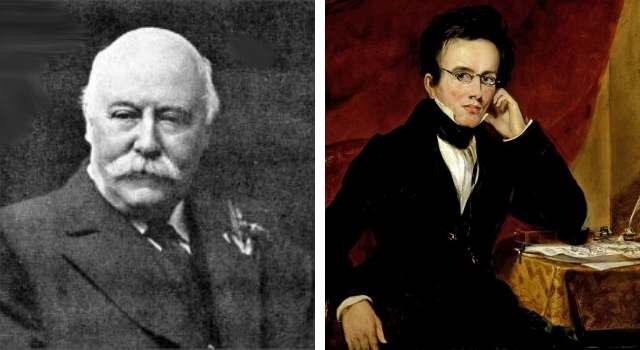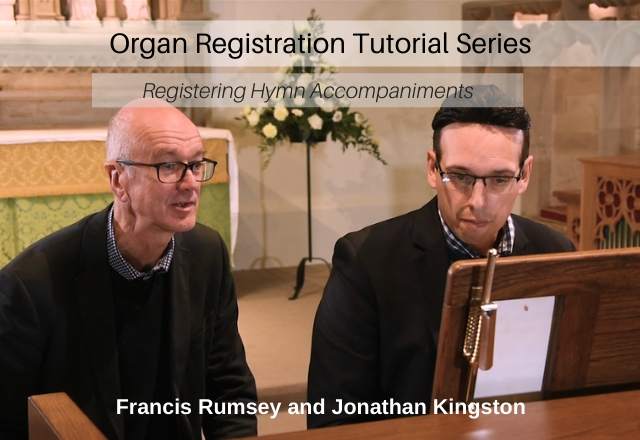For our fifth tutorial in the organ registration tutorials series, Francis discusses the registration of hymn accompaniments with Jonathan Kingston. Accompanying hymns is many organists’ primary role, and feedback suggests that a number of you would like to hear a bit more about this.
We’ve chosen three hymns —“Praise my soul the king of heaven”, “Dear Lord and Father”, and the more recent song “I, the Lord of sea and sky”— for this organ registration tutorial. These three hymns will provice a basis for discussing registration of playovers, verse contrasts, word painting, and last verses.
How robustly should the organist play?
The first topic that tends to come up when discussing hymn accompaniments is the question of how robustly to play. Most organists can recount stories about how difficult it can be to get this right.
One person’s “you play far too loud, I can hardly hear the Almighty speaking” is another person’s “I love it when you really go for it, it helps us sing confidently!” Like Brexit, it would seem, the country is divided on the matter.
Sensitive and supportive organ accompaniment
The organist’s job is to accompany sensitively and to support congregations in their singing. Sometimes, one can “pipe down” for a verse to let the choir) shine through, while for other verses one can encourage really robust congregational singing with an exciting full registration. A lot of this comes down to the words of the hymn and the opportunity to vary the registration accordingly, as well as the occasion, the liturgical context, and the size of the congregation.
You wouldn’t, for example, play a contemplative communion hymn on a Thursday with the same degree of robustness as the last verse of a Sunday closing hymn when the bishop has turned up. Sensitivity to the context and the words is almost always the key to making the right decision.
One of the things that Jonathan points out in talking about John Goss’s tune to “Praise my soul” is that one should generally aim to step the registration up a notch after the playover, rather than taking stops away, otherwise the congregation will feel a lack of support and may wonder what’s happened to the organ.
The same hymn offers a good range of options for varying the registration in the middle verses, especially if there’s a choir, with a different harmonization being set for the third verse and the opportunity for a gentler accompaniment. The last verse offers the chance for the organist to “let rip” a bit more if there is a lustily singing congregation and the choir is going for it nicely.

Organ accompaniment – Hubert Parry and Dan Schutte
“Dear Lord and Father”, to Parry’s popular tune Repton, the words surprisingly taken from Whittier’s poem about Vedic hallucinogenic rituals, offers a lot of opportunities for word painting. It’s a unison tune, so a good, solid diapason basis for accompaniment is ideal here, with a chance to vary the tone colours according to the mood of the words in the inner verses.
The last verse words suggest a dramatic crescendo towards “Let sense be dumb, let flesh retire; Speak through the earthquake, wind, and fire”, dropping back to something much gentler at “O still small voice of calm”.
Finally, we thought it would be interesting to look at the popular modern song, “I the Lord of sea and sky” by Dan Schutte, to see what can be done with this on the organ. Jonathan suggests that it can throw organists a few more challenges than usual, as it starts on the off-beat, so needs good articulation and a strong first pedal note to keep the rhythm moving forward. Jonathan says that he tends to concentrate on brightness of tone here. The little linking passage between the verses suggests dropping the organ tone down a notch at these points, adding a bit more as we move into the last verse, building the registration as one nears the end.

I’m a retired academic, with a background in music and audio engineering. I’m currently a consultant for Viscount & Regent Classic Organs, as well as being a freelance organist, including a role as organist/choirmaster at St Mary’s, Witney. I sing bass with Oxford Pro Musica Singers and the Cathedral Singers of Christ Church, Oxford.




Francis,
I really enjoy the organ tutorials. I play hymns
on an Envoy 35F in St Peter’s Jessopp Road
Church LEP, Norwich. One of our hymnbooks is ‘Singing the Faith’ which contains both traditional and modern hymns with a good selection of ‘Iona’ hymns. I find that some hymns in all categories sound and reflect the mood of the words better if the orchestral sounds are used on their own or mixed with organ sounds. In such cases I generally set up piano and strings on the great and orchestral trumpet and flute/strings on the swell.
This works well with both hymns and voluntarys contrasting organ flutes with strings. etc. i should be interested in hearing a tutorial from you explaining and giving professional advice and examples of this feature in the Envoy 35F organ.
Yours sincerely, Keith E. Poltock.